Design Thinking
VerifiedAdded on 2023/06/03
|10
|3061
|324
AI Summary
This report reviews Tim Brown's book on design thinking and its application in organizations. It discusses how the book contributes to the field of organizational change and leadership and how the concepts can be applied in real-world practice.
Contribute Materials
Your contribution can guide someone’s learning journey. Share your
documents today.
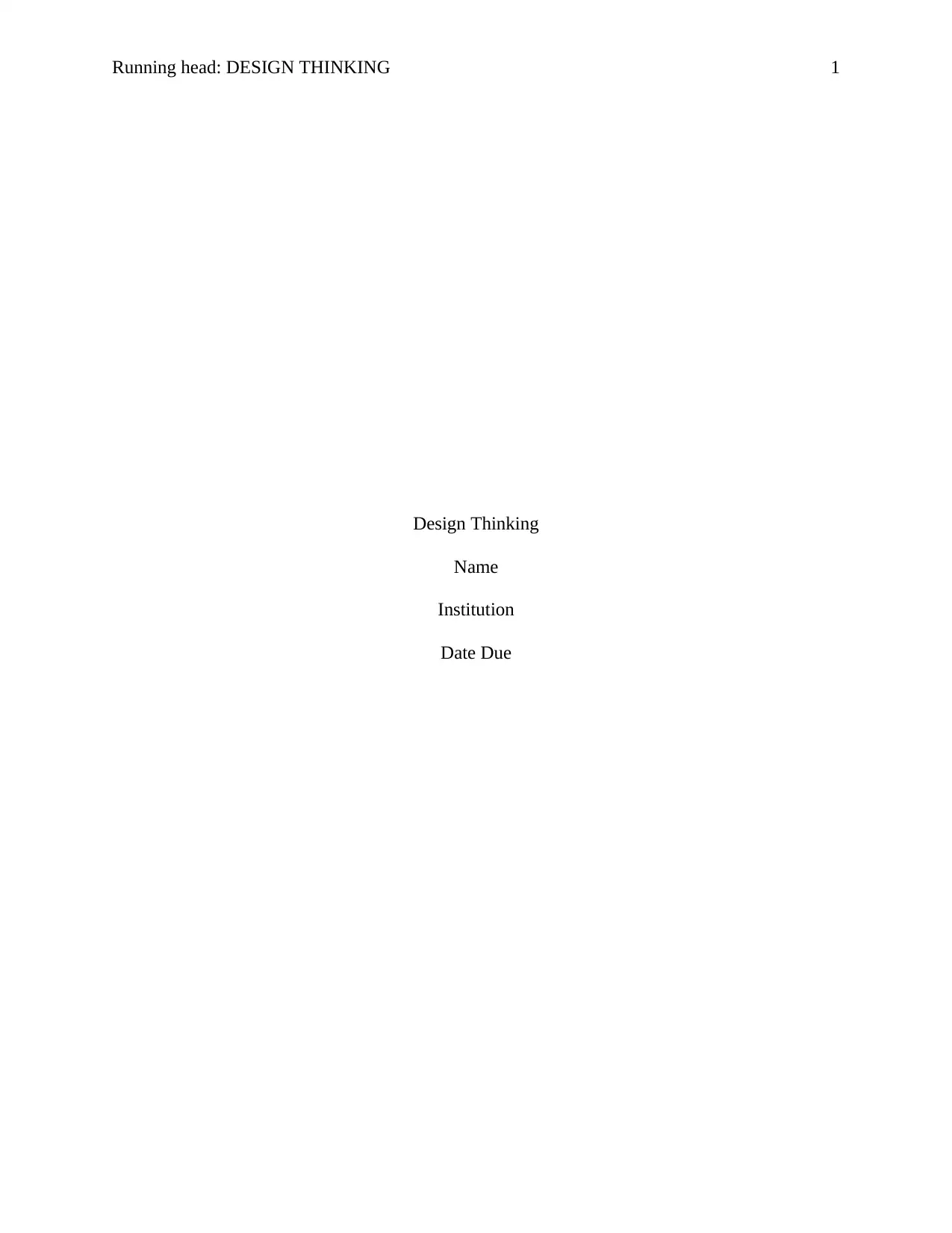
Running head: DESIGN THINKING 1
Design Thinking
Name
Institution
Date Due
Design Thinking
Name
Institution
Date Due
Secure Best Marks with AI Grader
Need help grading? Try our AI Grader for instant feedback on your assignments.
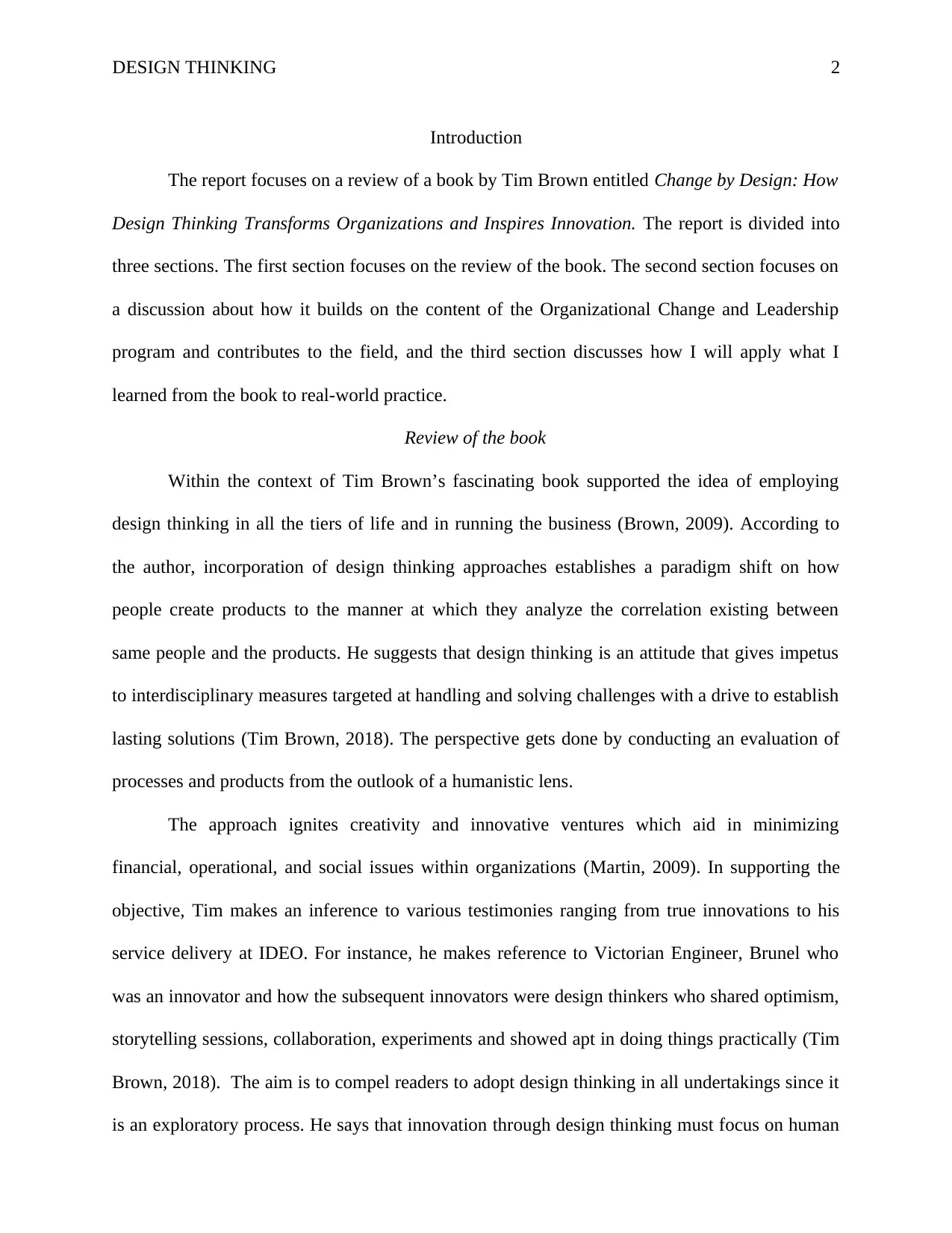
DESIGN THINKING 2
Introduction
The report focuses on a review of a book by Tim Brown entitled Change by Design: How
Design Thinking Transforms Organizations and Inspires Innovation. The report is divided into
three sections. The first section focuses on the review of the book. The second section focuses on
a discussion about how it builds on the content of the Organizational Change and Leadership
program and contributes to the field, and the third section discusses how I will apply what I
learned from the book to real-world practice.
Review of the book
Within the context of Tim Brown’s fascinating book supported the idea of employing
design thinking in all the tiers of life and in running the business (Brown, 2009). According to
the author, incorporation of design thinking approaches establishes a paradigm shift on how
people create products to the manner at which they analyze the correlation existing between
same people and the products. He suggests that design thinking is an attitude that gives impetus
to interdisciplinary measures targeted at handling and solving challenges with a drive to establish
lasting solutions (Tim Brown, 2018). The perspective gets done by conducting an evaluation of
processes and products from the outlook of a humanistic lens.
The approach ignites creativity and innovative ventures which aid in minimizing
financial, operational, and social issues within organizations (Martin, 2009). In supporting the
objective, Tim makes an inference to various testimonies ranging from true innovations to his
service delivery at IDEO. For instance, he makes reference to Victorian Engineer, Brunel who
was an innovator and how the subsequent innovators were design thinkers who shared optimism,
storytelling sessions, collaboration, experiments and showed apt in doing things practically (Tim
Brown, 2018). The aim is to compel readers to adopt design thinking in all undertakings since it
is an exploratory process. He says that innovation through design thinking must focus on human
Introduction
The report focuses on a review of a book by Tim Brown entitled Change by Design: How
Design Thinking Transforms Organizations and Inspires Innovation. The report is divided into
three sections. The first section focuses on the review of the book. The second section focuses on
a discussion about how it builds on the content of the Organizational Change and Leadership
program and contributes to the field, and the third section discusses how I will apply what I
learned from the book to real-world practice.
Review of the book
Within the context of Tim Brown’s fascinating book supported the idea of employing
design thinking in all the tiers of life and in running the business (Brown, 2009). According to
the author, incorporation of design thinking approaches establishes a paradigm shift on how
people create products to the manner at which they analyze the correlation existing between
same people and the products. He suggests that design thinking is an attitude that gives impetus
to interdisciplinary measures targeted at handling and solving challenges with a drive to establish
lasting solutions (Tim Brown, 2018). The perspective gets done by conducting an evaluation of
processes and products from the outlook of a humanistic lens.
The approach ignites creativity and innovative ventures which aid in minimizing
financial, operational, and social issues within organizations (Martin, 2009). In supporting the
objective, Tim makes an inference to various testimonies ranging from true innovations to his
service delivery at IDEO. For instance, he makes reference to Victorian Engineer, Brunel who
was an innovator and how the subsequent innovators were design thinkers who shared optimism,
storytelling sessions, collaboration, experiments and showed apt in doing things practically (Tim
Brown, 2018). The aim is to compel readers to adopt design thinking in all undertakings since it
is an exploratory process. He says that innovation through design thinking must focus on human
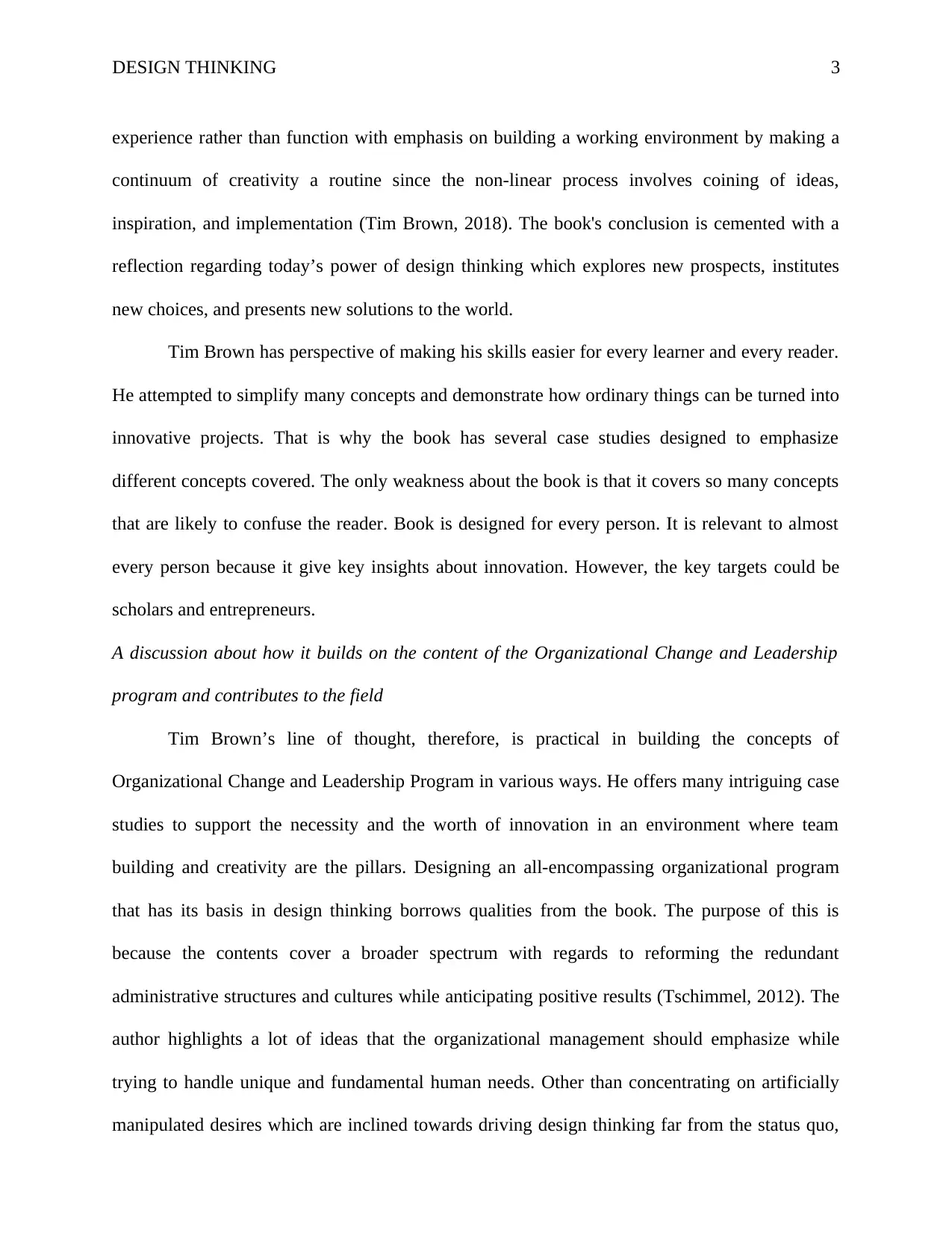
DESIGN THINKING 3
experience rather than function with emphasis on building a working environment by making a
continuum of creativity a routine since the non-linear process involves coining of ideas,
inspiration, and implementation (Tim Brown, 2018). The book's conclusion is cemented with a
reflection regarding today’s power of design thinking which explores new prospects, institutes
new choices, and presents new solutions to the world.
Tim Brown has perspective of making his skills easier for every learner and every reader.
He attempted to simplify many concepts and demonstrate how ordinary things can be turned into
innovative projects. That is why the book has several case studies designed to emphasize
different concepts covered. The only weakness about the book is that it covers so many concepts
that are likely to confuse the reader. Book is designed for every person. It is relevant to almost
every person because it give key insights about innovation. However, the key targets could be
scholars and entrepreneurs.
A discussion about how it builds on the content of the Organizational Change and Leadership
program and contributes to the field
Tim Brown’s line of thought, therefore, is practical in building the concepts of
Organizational Change and Leadership Program in various ways. He offers many intriguing case
studies to support the necessity and the worth of innovation in an environment where team
building and creativity are the pillars. Designing an all-encompassing organizational program
that has its basis in design thinking borrows qualities from the book. The purpose of this is
because the contents cover a broader spectrum with regards to reforming the redundant
administrative structures and cultures while anticipating positive results (Tschimmel, 2012). The
author highlights a lot of ideas that the organizational management should emphasize while
trying to handle unique and fundamental human needs. Other than concentrating on artificially
manipulated desires which are inclined towards driving design thinking far from the status quo,
experience rather than function with emphasis on building a working environment by making a
continuum of creativity a routine since the non-linear process involves coining of ideas,
inspiration, and implementation (Tim Brown, 2018). The book's conclusion is cemented with a
reflection regarding today’s power of design thinking which explores new prospects, institutes
new choices, and presents new solutions to the world.
Tim Brown has perspective of making his skills easier for every learner and every reader.
He attempted to simplify many concepts and demonstrate how ordinary things can be turned into
innovative projects. That is why the book has several case studies designed to emphasize
different concepts covered. The only weakness about the book is that it covers so many concepts
that are likely to confuse the reader. Book is designed for every person. It is relevant to almost
every person because it give key insights about innovation. However, the key targets could be
scholars and entrepreneurs.
A discussion about how it builds on the content of the Organizational Change and Leadership
program and contributes to the field
Tim Brown’s line of thought, therefore, is practical in building the concepts of
Organizational Change and Leadership Program in various ways. He offers many intriguing case
studies to support the necessity and the worth of innovation in an environment where team
building and creativity are the pillars. Designing an all-encompassing organizational program
that has its basis in design thinking borrows qualities from the book. The purpose of this is
because the contents cover a broader spectrum with regards to reforming the redundant
administrative structures and cultures while anticipating positive results (Tschimmel, 2012). The
author highlights a lot of ideas that the organizational management should emphasize while
trying to handle unique and fundamental human needs. Other than concentrating on artificially
manipulated desires which are inclined towards driving design thinking far from the status quo,
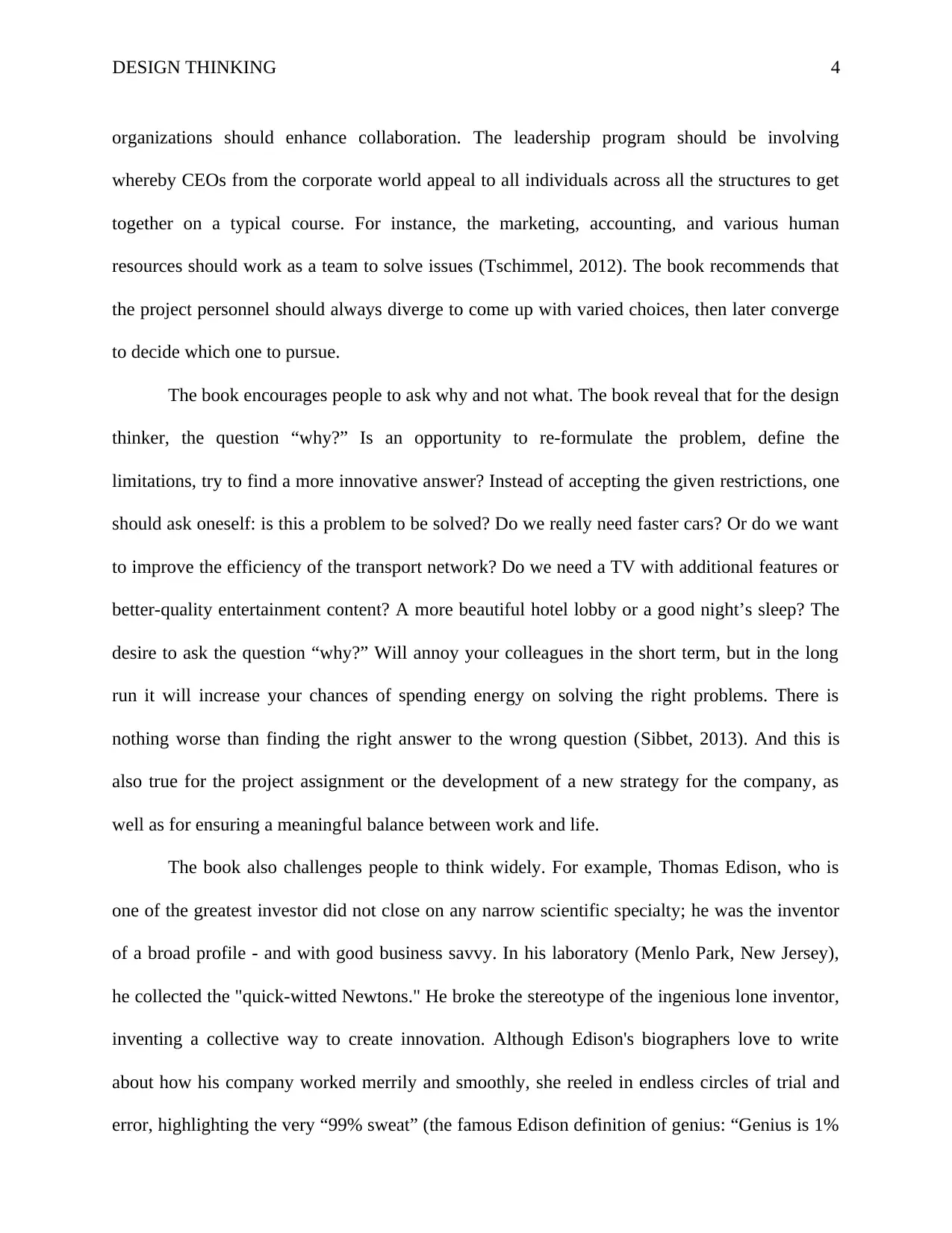
DESIGN THINKING 4
organizations should enhance collaboration. The leadership program should be involving
whereby CEOs from the corporate world appeal to all individuals across all the structures to get
together on a typical course. For instance, the marketing, accounting, and various human
resources should work as a team to solve issues (Tschimmel, 2012). The book recommends that
the project personnel should always diverge to come up with varied choices, then later converge
to decide which one to pursue.
The book encourages people to ask why and not what. The book reveal that for the design
thinker, the question “why?” Is an opportunity to re-formulate the problem, define the
limitations, try to find a more innovative answer? Instead of accepting the given restrictions, one
should ask oneself: is this a problem to be solved? Do we really need faster cars? Or do we want
to improve the efficiency of the transport network? Do we need a TV with additional features or
better-quality entertainment content? A more beautiful hotel lobby or a good night’s sleep? The
desire to ask the question “why?” Will annoy your colleagues in the short term, but in the long
run it will increase your chances of spending energy on solving the right problems. There is
nothing worse than finding the right answer to the wrong question (Sibbet, 2013). And this is
also true for the project assignment or the development of a new strategy for the company, as
well as for ensuring a meaningful balance between work and life.
The book also challenges people to think widely. For example, Thomas Edison, who is
one of the greatest investor did not close on any narrow scientific specialty; he was the inventor
of a broad profile - and with good business savvy. In his laboratory (Menlo Park, New Jersey),
he collected the "quick-witted Newtons." He broke the stereotype of the ingenious lone inventor,
inventing a collective way to create innovation. Although Edison's biographers love to write
about how his company worked merrily and smoothly, she reeled in endless circles of trial and
error, highlighting the very “99% sweat” (the famous Edison definition of genius: “Genius is 1%
organizations should enhance collaboration. The leadership program should be involving
whereby CEOs from the corporate world appeal to all individuals across all the structures to get
together on a typical course. For instance, the marketing, accounting, and various human
resources should work as a team to solve issues (Tschimmel, 2012). The book recommends that
the project personnel should always diverge to come up with varied choices, then later converge
to decide which one to pursue.
The book encourages people to ask why and not what. The book reveal that for the design
thinker, the question “why?” Is an opportunity to re-formulate the problem, define the
limitations, try to find a more innovative answer? Instead of accepting the given restrictions, one
should ask oneself: is this a problem to be solved? Do we really need faster cars? Or do we want
to improve the efficiency of the transport network? Do we need a TV with additional features or
better-quality entertainment content? A more beautiful hotel lobby or a good night’s sleep? The
desire to ask the question “why?” Will annoy your colleagues in the short term, but in the long
run it will increase your chances of spending energy on solving the right problems. There is
nothing worse than finding the right answer to the wrong question (Sibbet, 2013). And this is
also true for the project assignment or the development of a new strategy for the company, as
well as for ensuring a meaningful balance between work and life.
The book also challenges people to think widely. For example, Thomas Edison, who is
one of the greatest investor did not close on any narrow scientific specialty; he was the inventor
of a broad profile - and with good business savvy. In his laboratory (Menlo Park, New Jersey),
he collected the "quick-witted Newtons." He broke the stereotype of the ingenious lone inventor,
inventing a collective way to create innovation. Although Edison's biographers love to write
about how his company worked merrily and smoothly, she reeled in endless circles of trial and
error, highlighting the very “99% sweat” (the famous Edison definition of genius: “Genius is 1%
Secure Best Marks with AI Grader
Need help grading? Try our AI Grader for instant feedback on your assignments.

DESIGN THINKING 5
inspiration and 99% sweat "). He did not rely on testing ready-made hypotheses, where it was
more important for him to help his staff extract nuggets of new knowledge from each
experiment. Innovation is hard work (Liedtka, Bennett, & King, 2013); Edison made inventing a
profession that incorporated art, craftsmanship, business experience, and understanding of the
market and consumers. Design thinking is a direct follower of this tradition.
Another key concept expressed in the book is that design thinking has changed and that
people should not use the mentality that was used several decades ago. Historically, an
insignificant role was assigned to design in the development process: all the innovative work was
done, and designers started to do business — they come up with a beautiful “packaging” for the
idea (Australia, 2015). This principle, by the way, contributed to the growth of the market in
many industries: new products and technologies were aesthetically pleasing to customers, and
advertising, more elegant and catchy, supported by a competent strategy for working with the
media, attracted more attention to the brand. In the second half of the twentieth century, design
gradually acquired the value of a valuable competitive asset, especially in consumer electronics,
automotive, packaged goods. But for most industries, the design was still something of
secondary importance - it was at the very end that the line reached it (In Brenner & In
Uebernickel, 2016). But now companies turn to designers not so much for beautiful packaging
for ready-made ideas, now they need the ideas themselves, more responsive to the needs and
needs of people. The former role of design was tactical, because the design itself had no
independent meaning; A new role is strategic, it allows you to create something fundamentally
new (Liedtka & Ogilvie, 2011). Moreover, now in the economy of developed countries there is a
shift from industrial production to intellectual work, therefore, new open spaces for innovation
are opening up. Now it is aimed not only at specific products, but also at new processes, services,
and the sphere of entertainment. And it is in these areas that design thinking can play a crucial
inspiration and 99% sweat "). He did not rely on testing ready-made hypotheses, where it was
more important for him to help his staff extract nuggets of new knowledge from each
experiment. Innovation is hard work (Liedtka, Bennett, & King, 2013); Edison made inventing a
profession that incorporated art, craftsmanship, business experience, and understanding of the
market and consumers. Design thinking is a direct follower of this tradition.
Another key concept expressed in the book is that design thinking has changed and that
people should not use the mentality that was used several decades ago. Historically, an
insignificant role was assigned to design in the development process: all the innovative work was
done, and designers started to do business — they come up with a beautiful “packaging” for the
idea (Australia, 2015). This principle, by the way, contributed to the growth of the market in
many industries: new products and technologies were aesthetically pleasing to customers, and
advertising, more elegant and catchy, supported by a competent strategy for working with the
media, attracted more attention to the brand. In the second half of the twentieth century, design
gradually acquired the value of a valuable competitive asset, especially in consumer electronics,
automotive, packaged goods. But for most industries, the design was still something of
secondary importance - it was at the very end that the line reached it (In Brenner & In
Uebernickel, 2016). But now companies turn to designers not so much for beautiful packaging
for ready-made ideas, now they need the ideas themselves, more responsive to the needs and
needs of people. The former role of design was tactical, because the design itself had no
independent meaning; A new role is strategic, it allows you to create something fundamentally
new (Liedtka & Ogilvie, 2011). Moreover, now in the economy of developed countries there is a
shift from industrial production to intellectual work, therefore, new open spaces for innovation
are opening up. Now it is aimed not only at specific products, but also at new processes, services,
and the sphere of entertainment. And it is in these areas that design thinking can play a crucial
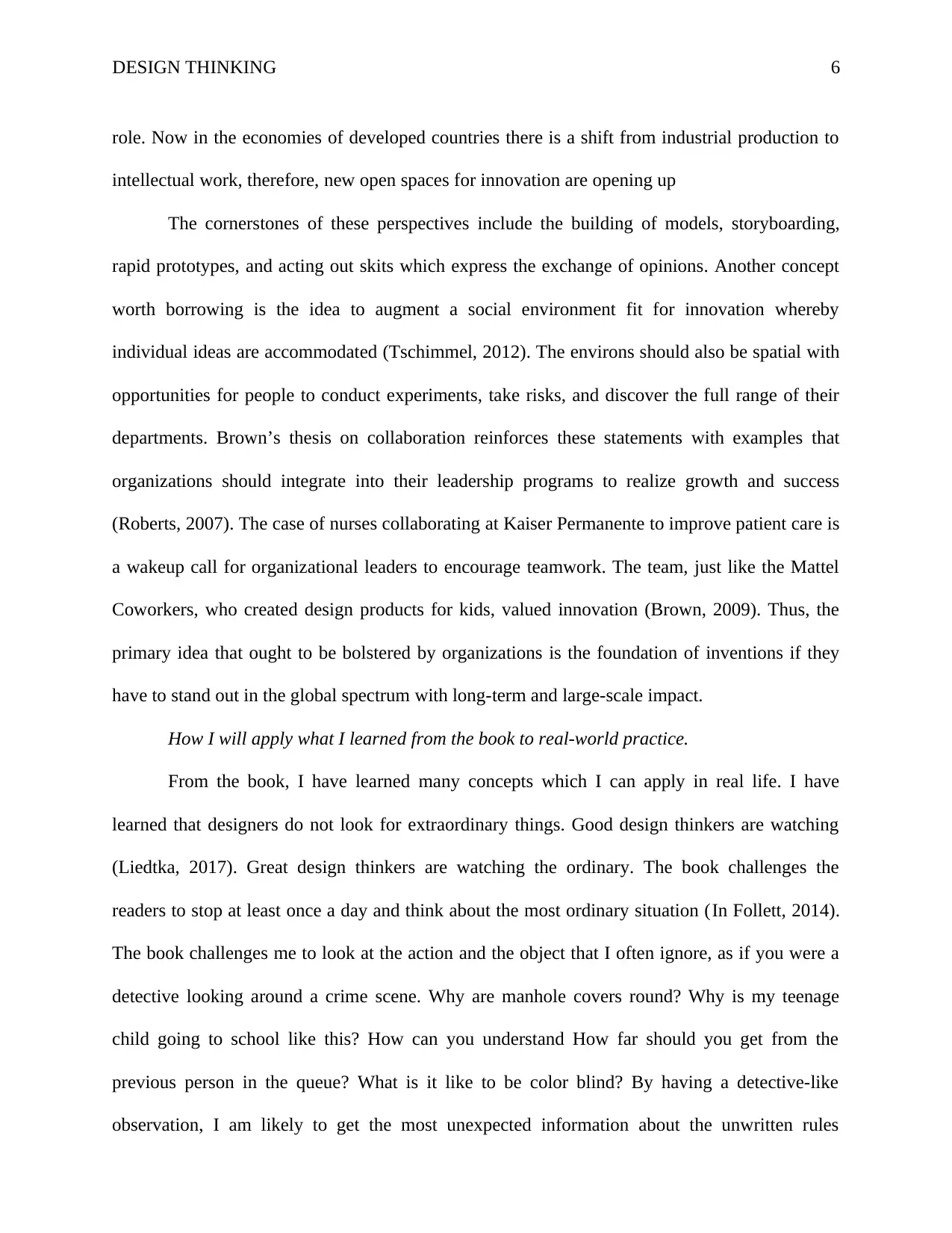
DESIGN THINKING 6
role. Now in the economies of developed countries there is a shift from industrial production to
intellectual work, therefore, new open spaces for innovation are opening up
The cornerstones of these perspectives include the building of models, storyboarding,
rapid prototypes, and acting out skits which express the exchange of opinions. Another concept
worth borrowing is the idea to augment a social environment fit for innovation whereby
individual ideas are accommodated (Tschimmel, 2012). The environs should also be spatial with
opportunities for people to conduct experiments, take risks, and discover the full range of their
departments. Brown’s thesis on collaboration reinforces these statements with examples that
organizations should integrate into their leadership programs to realize growth and success
(Roberts, 2007). The case of nurses collaborating at Kaiser Permanente to improve patient care is
a wakeup call for organizational leaders to encourage teamwork. The team, just like the Mattel
Coworkers, who created design products for kids, valued innovation (Brown, 2009). Thus, the
primary idea that ought to be bolstered by organizations is the foundation of inventions if they
have to stand out in the global spectrum with long-term and large-scale impact.
How I will apply what I learned from the book to real-world practice.
From the book, I have learned many concepts which I can apply in real life. I have
learned that designers do not look for extraordinary things. Good design thinkers are watching
(Liedtka, 2017). Great design thinkers are watching the ordinary. The book challenges the
readers to stop at least once a day and think about the most ordinary situation (In Follett, 2014).
The book challenges me to look at the action and the object that I often ignore, as if you were a
detective looking around a crime scene. Why are manhole covers round? Why is my teenage
child going to school like this? How can you understand How far should you get from the
previous person in the queue? What is it like to be color blind? By having a detective-like
observation, I am likely to get the most unexpected information about the unwritten rules
role. Now in the economies of developed countries there is a shift from industrial production to
intellectual work, therefore, new open spaces for innovation are opening up
The cornerstones of these perspectives include the building of models, storyboarding,
rapid prototypes, and acting out skits which express the exchange of opinions. Another concept
worth borrowing is the idea to augment a social environment fit for innovation whereby
individual ideas are accommodated (Tschimmel, 2012). The environs should also be spatial with
opportunities for people to conduct experiments, take risks, and discover the full range of their
departments. Brown’s thesis on collaboration reinforces these statements with examples that
organizations should integrate into their leadership programs to realize growth and success
(Roberts, 2007). The case of nurses collaborating at Kaiser Permanente to improve patient care is
a wakeup call for organizational leaders to encourage teamwork. The team, just like the Mattel
Coworkers, who created design products for kids, valued innovation (Brown, 2009). Thus, the
primary idea that ought to be bolstered by organizations is the foundation of inventions if they
have to stand out in the global spectrum with long-term and large-scale impact.
How I will apply what I learned from the book to real-world practice.
From the book, I have learned many concepts which I can apply in real life. I have
learned that designers do not look for extraordinary things. Good design thinkers are watching
(Liedtka, 2017). Great design thinkers are watching the ordinary. The book challenges the
readers to stop at least once a day and think about the most ordinary situation (In Follett, 2014).
The book challenges me to look at the action and the object that I often ignore, as if you were a
detective looking around a crime scene. Why are manhole covers round? Why is my teenage
child going to school like this? How can you understand How far should you get from the
previous person in the queue? What is it like to be color blind? By having a detective-like
observation, I am likely to get the most unexpected information about the unwritten rules

DESIGN THINKING 7
governing a person’s life. One of the cases that justifies this is the case of Thomas Edison.
Edison invented a light bulb, and then created around it a whole industry – energy (Kesler &
Kates, 2011). An incandescent lamp is considered to be its “proprietary” invention, its business
card, but Edison himself understood that these are all toys: there is no sense without a system for
generating and transmitting electricity from the bulb itself. So he invented all this too. It turns out
that Edison could imagine not just a separate device, but a fully developed market, the whole
system of its consumption - this is the essence of his genius. He managed to predict how people
would use his inventions, and he worked in accordance with this foresight. Sometimes he was
mistaken (for example, he initially thought that the phonograph would be needed mainly by
institutions for recording and reproducing dictations), but he was incredibly attentive to the needs
and preferences of people (Lockwood & Papke, 2018). Edison's approach to business is one of
the first examples of what is now called designer thinking, which suggests that all work of the
creator of a new person is focused on people (Mootee, 2013). That is, it can be said that
innovations are implicated in the deep knowledge of people, understanding of what they want,
what they like or dislike in specific products and their packaging, in advertising, sales and
support services, an understanding that comes only as a result of direct observation of real life
(Stickdorn, Schneider & Andrews, 2011).
Lastly, the book challenges me that the work of the designer is not a thoughtful series of
consecutive steps, but rather a system of creative zones. These zones, interconnected activities,
like details of a mosaic, form a single space of innovation. For those who come into contact with
this method for the first time, design thinking may seem chaotic (Schmiedgen, & Hasso-Plattner-
Institut für Softwaresystemtechnik 2015) . But along the way, participants are beginning to
understand that this is a meaningful process, leading to concrete results, although it differs from
linear, business-specific processes. Total design projects must go through three zones. The first
governing a person’s life. One of the cases that justifies this is the case of Thomas Edison.
Edison invented a light bulb, and then created around it a whole industry – energy (Kesler &
Kates, 2011). An incandescent lamp is considered to be its “proprietary” invention, its business
card, but Edison himself understood that these are all toys: there is no sense without a system for
generating and transmitting electricity from the bulb itself. So he invented all this too. It turns out
that Edison could imagine not just a separate device, but a fully developed market, the whole
system of its consumption - this is the essence of his genius. He managed to predict how people
would use his inventions, and he worked in accordance with this foresight. Sometimes he was
mistaken (for example, he initially thought that the phonograph would be needed mainly by
institutions for recording and reproducing dictations), but he was incredibly attentive to the needs
and preferences of people (Lockwood & Papke, 2018). Edison's approach to business is one of
the first examples of what is now called designer thinking, which suggests that all work of the
creator of a new person is focused on people (Mootee, 2013). That is, it can be said that
innovations are implicated in the deep knowledge of people, understanding of what they want,
what they like or dislike in specific products and their packaging, in advertising, sales and
support services, an understanding that comes only as a result of direct observation of real life
(Stickdorn, Schneider & Andrews, 2011).
Lastly, the book challenges me that the work of the designer is not a thoughtful series of
consecutive steps, but rather a system of creative zones. These zones, interconnected activities,
like details of a mosaic, form a single space of innovation. For those who come into contact with
this method for the first time, design thinking may seem chaotic (Schmiedgen, & Hasso-Plattner-
Institut für Softwaresystemtechnik 2015) . But along the way, participants are beginning to
understand that this is a meaningful process, leading to concrete results, although it differs from
linear, business-specific processes. Total design projects must go through three zones. The first
Paraphrase This Document
Need a fresh take? Get an instant paraphrase of this document with our AI Paraphraser
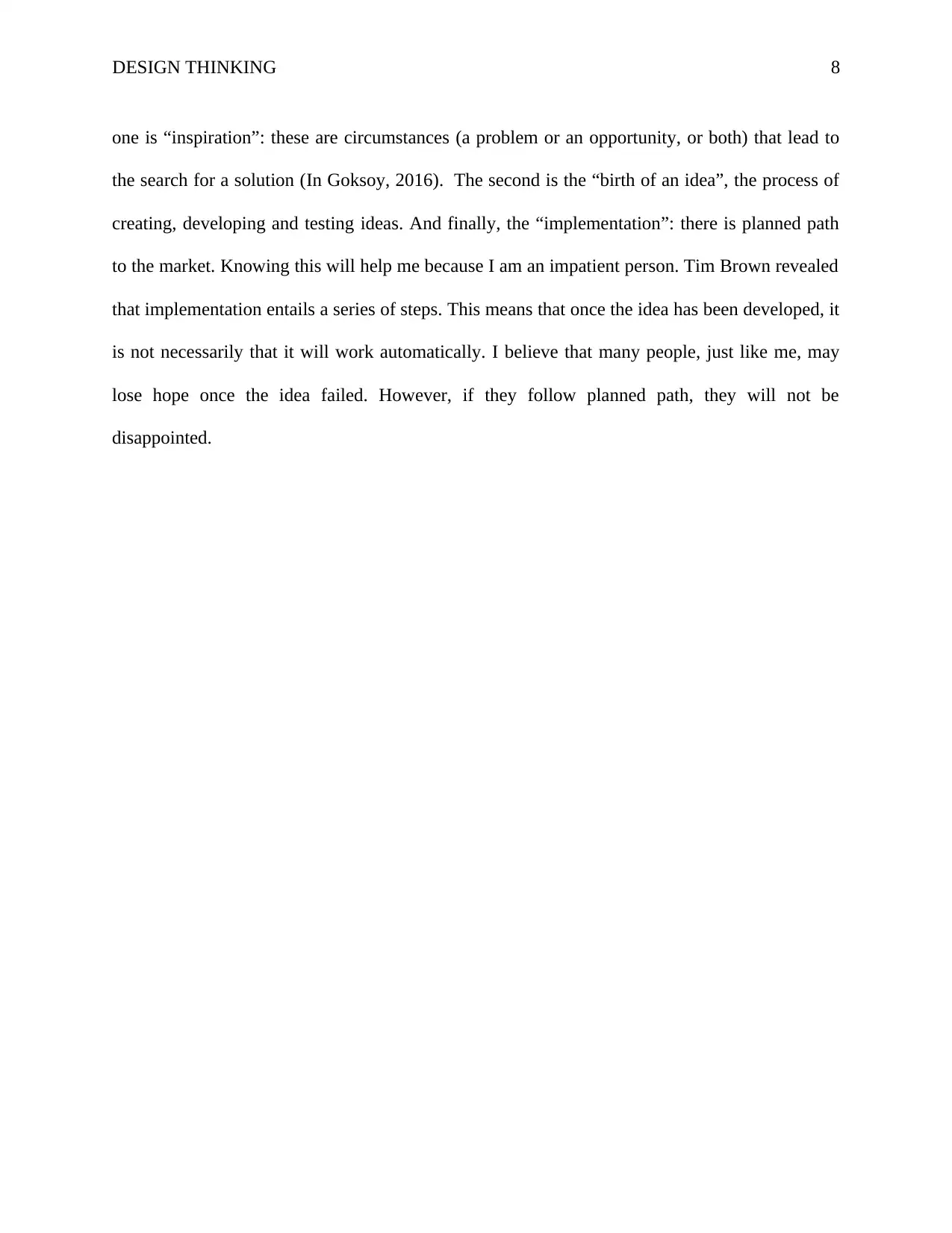
DESIGN THINKING 8
one is “inspiration”: these are circumstances (a problem or an opportunity, or both) that lead to
the search for a solution (In Goksoy, 2016). The second is the “birth of an idea”, the process of
creating, developing and testing ideas. And finally, the “implementation”: there is planned path
to the market. Knowing this will help me because I am an impatient person. Tim Brown revealed
that implementation entails a series of steps. This means that once the idea has been developed, it
is not necessarily that it will work automatically. I believe that many people, just like me, may
lose hope once the idea failed. However, if they follow planned path, they will not be
disappointed.
one is “inspiration”: these are circumstances (a problem or an opportunity, or both) that lead to
the search for a solution (In Goksoy, 2016). The second is the “birth of an idea”, the process of
creating, developing and testing ideas. And finally, the “implementation”: there is planned path
to the market. Knowing this will help me because I am an impatient person. Tim Brown revealed
that implementation entails a series of steps. This means that once the idea has been developed, it
is not necessarily that it will work automatically. I believe that many people, just like me, may
lose hope once the idea failed. However, if they follow planned path, they will not be
disappointed.
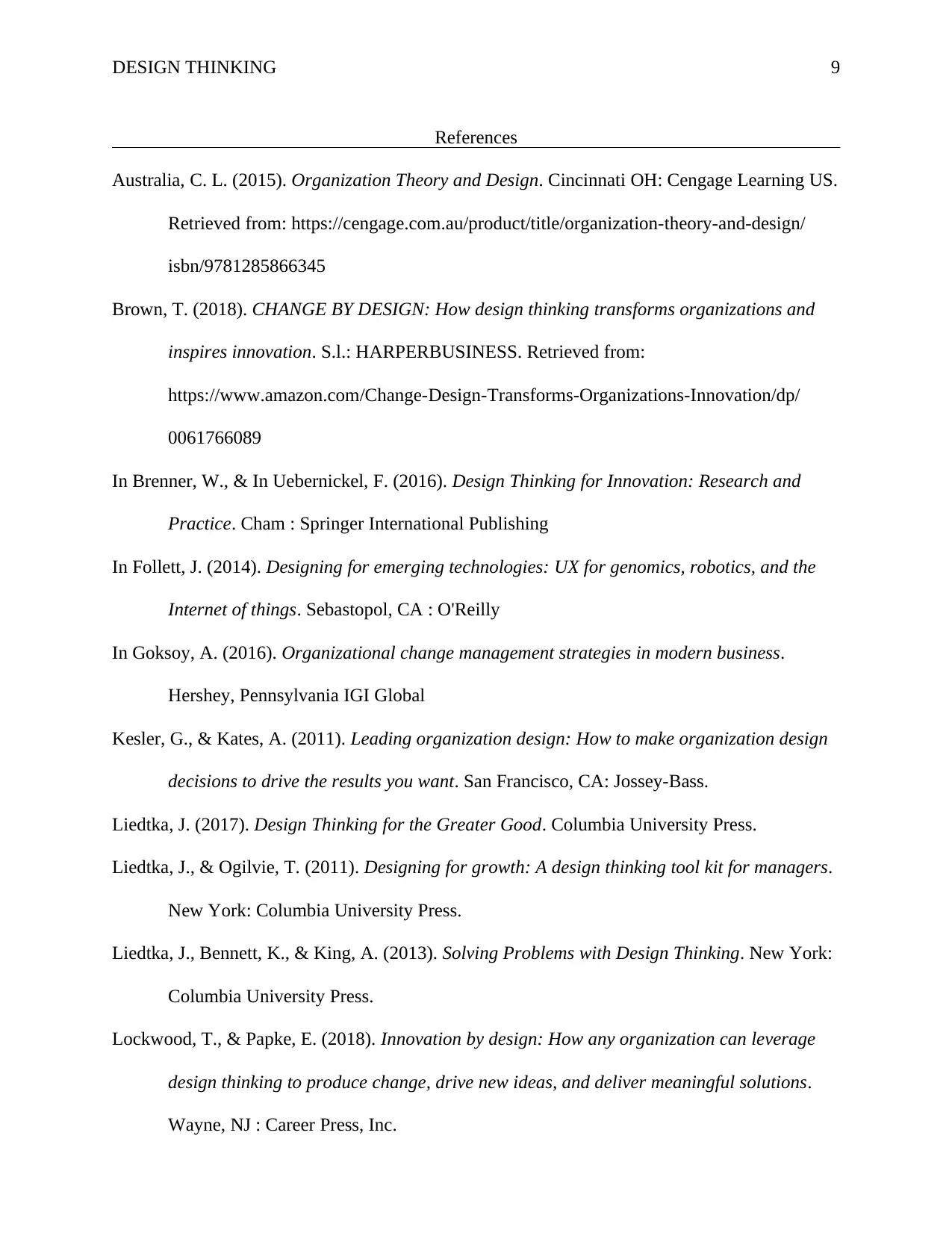
DESIGN THINKING 9
References
Australia, C. L. (2015). Organization Theory and Design. Cincinnati OH: Cengage Learning US.
Retrieved from: https://cengage.com.au/product/title/organization-theory-and-design/
isbn/9781285866345
Brown, T. (2018). CHANGE BY DESIGN: How design thinking transforms organizations and
inspires innovation. S.l.: HARPERBUSINESS. Retrieved from:
https://www.amazon.com/Change-Design-Transforms-Organizations-Innovation/dp/
0061766089
In Brenner, W., & In Uebernickel, F. (2016). Design Thinking for Innovation: Research and
Practice. Cham : Springer International Publishing
In Follett, J. (2014). Designing for emerging technologies: UX for genomics, robotics, and the
Internet of things. Sebastopol, CA : O'Reilly
In Goksoy, A. (2016). Organizational change management strategies in modern business.
Hershey, Pennsylvania IGI Global
Kesler, G., & Kates, A. (2011). Leading organization design: How to make organization design
decisions to drive the results you want. San Francisco, CA: Jossey-Bass.
Liedtka, J. (2017). Design Thinking for the Greater Good. Columbia University Press.
Liedtka, J., & Ogilvie, T. (2011). Designing for growth: A design thinking tool kit for managers.
New York: Columbia University Press.
Liedtka, J., Bennett, K., & King, A. (2013). Solving Problems with Design Thinking. New York:
Columbia University Press.
Lockwood, T., & Papke, E. (2018). Innovation by design: How any organization can leverage
design thinking to produce change, drive new ideas, and deliver meaningful solutions.
Wayne, NJ : Career Press, Inc.
References
Australia, C. L. (2015). Organization Theory and Design. Cincinnati OH: Cengage Learning US.
Retrieved from: https://cengage.com.au/product/title/organization-theory-and-design/
isbn/9781285866345
Brown, T. (2018). CHANGE BY DESIGN: How design thinking transforms organizations and
inspires innovation. S.l.: HARPERBUSINESS. Retrieved from:
https://www.amazon.com/Change-Design-Transforms-Organizations-Innovation/dp/
0061766089
In Brenner, W., & In Uebernickel, F. (2016). Design Thinking for Innovation: Research and
Practice. Cham : Springer International Publishing
In Follett, J. (2014). Designing for emerging technologies: UX for genomics, robotics, and the
Internet of things. Sebastopol, CA : O'Reilly
In Goksoy, A. (2016). Organizational change management strategies in modern business.
Hershey, Pennsylvania IGI Global
Kesler, G., & Kates, A. (2011). Leading organization design: How to make organization design
decisions to drive the results you want. San Francisco, CA: Jossey-Bass.
Liedtka, J. (2017). Design Thinking for the Greater Good. Columbia University Press.
Liedtka, J., & Ogilvie, T. (2011). Designing for growth: A design thinking tool kit for managers.
New York: Columbia University Press.
Liedtka, J., Bennett, K., & King, A. (2013). Solving Problems with Design Thinking. New York:
Columbia University Press.
Lockwood, T., & Papke, E. (2018). Innovation by design: How any organization can leverage
design thinking to produce change, drive new ideas, and deliver meaningful solutions.
Wayne, NJ : Career Press, Inc.
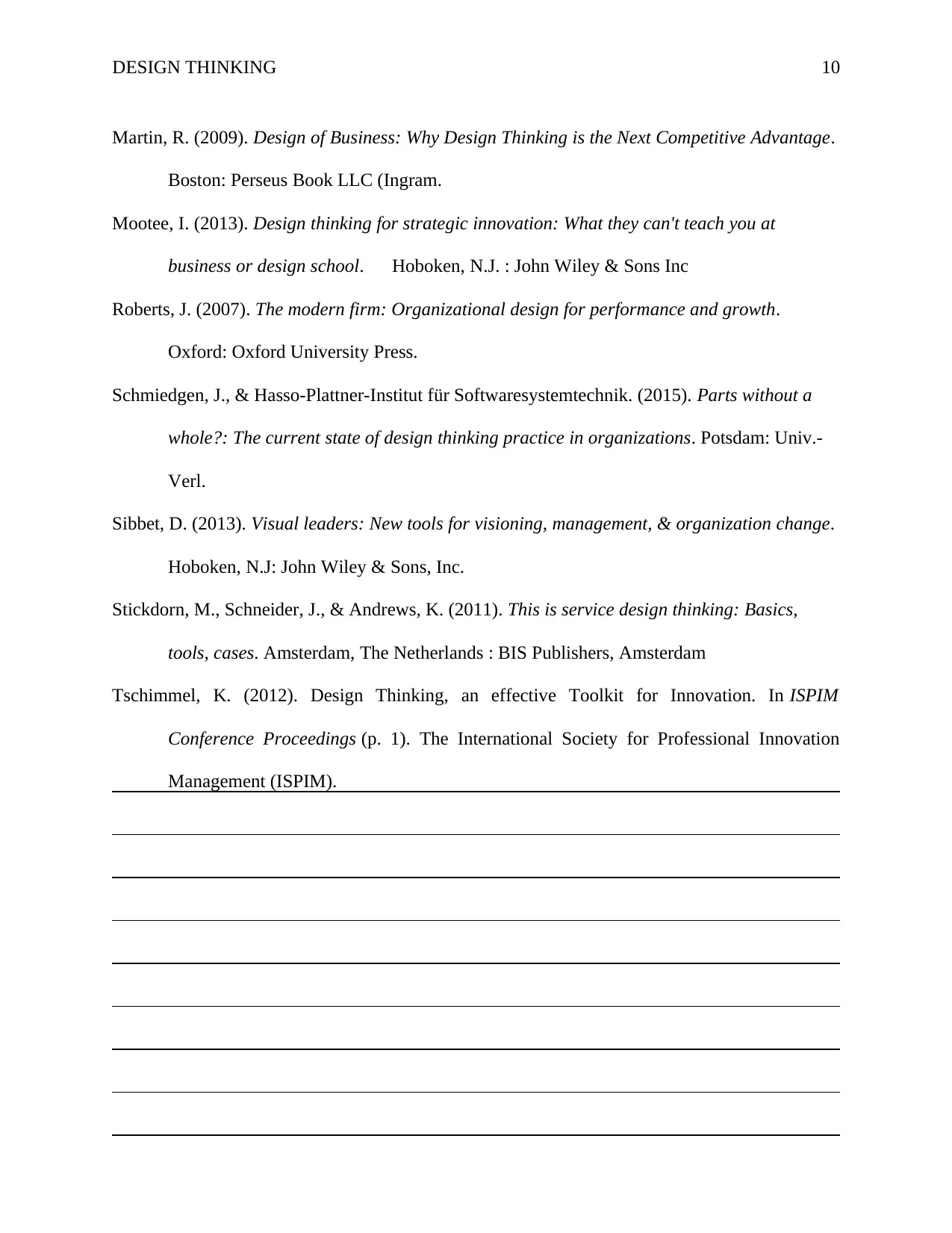
DESIGN THINKING 10
Martin, R. (2009). Design of Business: Why Design Thinking is the Next Competitive Advantage.
Boston: Perseus Book LLC (Ingram.
Mootee, I. (2013). Design thinking for strategic innovation: What they can't teach you at
business or design school. Hoboken, N.J. : John Wiley & Sons Inc
Roberts, J. (2007). The modern firm: Organizational design for performance and growth.
Oxford: Oxford University Press.
Schmiedgen, J., & Hasso-Plattner-Institut für Softwaresystemtechnik. (2015). Parts without a
whole?: The current state of design thinking practice in organizations. Potsdam: Univ.-
Verl.
Sibbet, D. (2013). Visual leaders: New tools for visioning, management, & organization change.
Hoboken, N.J: John Wiley & Sons, Inc.
Stickdorn, M., Schneider, J., & Andrews, K. (2011). This is service design thinking: Basics,
tools, cases. Amsterdam, The Netherlands : BIS Publishers, Amsterdam
Tschimmel, K. (2012). Design Thinking, an effective Toolkit for Innovation. In ISPIM
Conference Proceedings (p. 1). The International Society for Professional Innovation
Management (ISPIM).
Martin, R. (2009). Design of Business: Why Design Thinking is the Next Competitive Advantage.
Boston: Perseus Book LLC (Ingram.
Mootee, I. (2013). Design thinking for strategic innovation: What they can't teach you at
business or design school. Hoboken, N.J. : John Wiley & Sons Inc
Roberts, J. (2007). The modern firm: Organizational design for performance and growth.
Oxford: Oxford University Press.
Schmiedgen, J., & Hasso-Plattner-Institut für Softwaresystemtechnik. (2015). Parts without a
whole?: The current state of design thinking practice in organizations. Potsdam: Univ.-
Verl.
Sibbet, D. (2013). Visual leaders: New tools for visioning, management, & organization change.
Hoboken, N.J: John Wiley & Sons, Inc.
Stickdorn, M., Schneider, J., & Andrews, K. (2011). This is service design thinking: Basics,
tools, cases. Amsterdam, The Netherlands : BIS Publishers, Amsterdam
Tschimmel, K. (2012). Design Thinking, an effective Toolkit for Innovation. In ISPIM
Conference Proceedings (p. 1). The International Society for Professional Innovation
Management (ISPIM).
1 out of 10
Related Documents
Your All-in-One AI-Powered Toolkit for Academic Success.
+13062052269
info@desklib.com
Available 24*7 on WhatsApp / Email
![[object Object]](/_next/static/media/star-bottom.7253800d.svg)
Unlock your academic potential
© 2024 | Zucol Services PVT LTD | All rights reserved.




